Operation: Düsseldorf
Date: 03/04th November 1943 (Wednesday/Thursday)
Unit: No. 625 Squadron
Type: Lancaster I
Serial: W4833
Code: CF-J
Base: RAF Kelstern, Lincolnshire
Location: Base
Pilot: Fl/Sgt. Reginald Price RCAF
Fl/Eng: Sgt. Les Knowles RAFVR
Nav: P/O. Dudley Edgar Ball AUS/420849 RAAF Age 22.
Air/Bmr: P/O. Jack Conley RAAF
W/Op/Air/Gnr: Sgt. Jim Harris RAFVR
Air/Gnr: Sgt. Harry William Powter 1890677 RAFVR Age 19.
Air/Gnr: P/O. Frank Sutton RAFVR
REASON FOR LOSS:
Page submitted to Aircrew Remembered in January 2018 by Jack Albrecht with information supplied by Reg Price and John Proctor.
For this operation the Squadron detailed fifteen aircraft, including Lancaster I, “J”- W4833, piloted by Fl/Sgt. Reg Price. The remainder of the crew as listed above.
This was a raw crew on their second op after an initial grind to Kassel on Oct.22/43. It was Fl/Sgt. Price’s third introduction to combat with a ‘second dickey’ ride to Leipzig with P/O. Pickles on Oct. 20/43. This would be a flight to test their mettle. Their battle fatigued aircraft was at maximum gross take-off weight with fuel and bomb load, including a 4000 pound ‘cookie’. With the green Very light from the control shack Fl/Sgt. Price applied full boost to the four Merlins and accelerated down runway 06 in total darkness. Once airborne, undercarriage and flaps retracted, at an altitude of 300 feet, the flight engineer reported flames spewing from the starboard inner engine. The fire was promptly extinguished and prop feathered. Fl/Sgt. Price struggled to maintain altitude. Without warning the port inner failed and was secured. Level flight was no longer feasible and W4833 began a gradual descent.
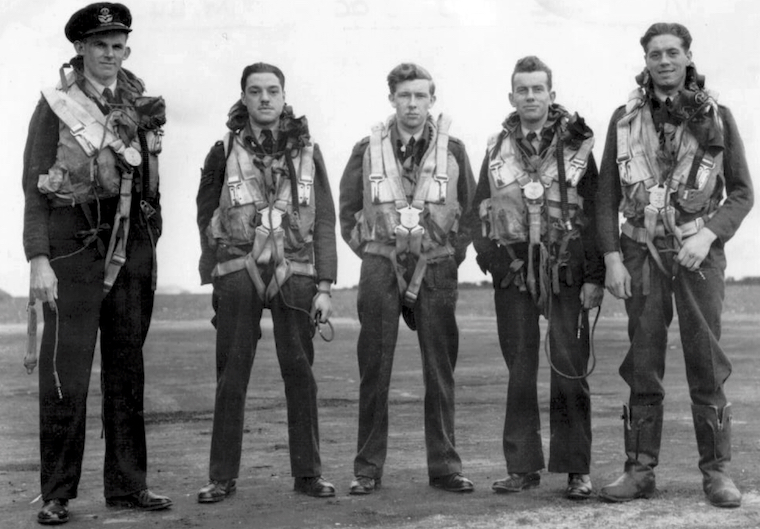
Above L-R; P/O.Ball DFC, Sgt. Knowles, P/O. Price DFC, P/O. Conley DFC, P/O. Sutton.
An urgent coordinated effort by the crew to lighten their aircraft by jettisoning all loose objects including ammunition and even the navigators sextant managed to reduce their sink rate. Fl/Sgt. Price noted that their fate was determined by two facts: the dual engine failure was on opposing wings and the seventy mile departure east to the North Sea was over descending terrain. He had no idea of how close they came to ground impact and was glad he didn’t! On reaching the coast the incendiaries were jettisoned and a gradual climb was initiated to 4000 ft, the safe altitude to release the ‘cookie’ without damage from the ensuing explosion. After a 1hr. 15 min. aborted op Fl/Sgt. Price made a textbook two engine landing at Base. A relieved crew exited, happy to be back on terra firma. Their teamwork and coordination exemplified the seven link gold chain incorporated into the Squadron crest, allowing them to live and fight another day.
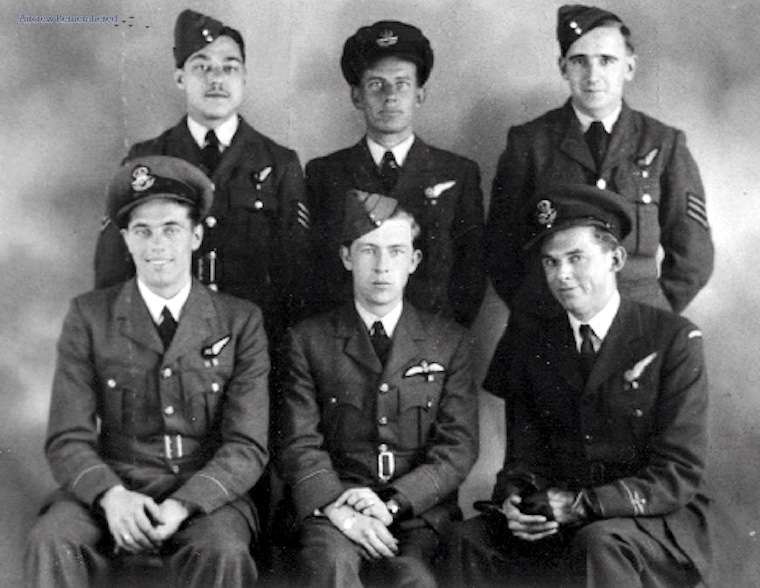 Above Rear L-R: Sgt. Les Knowles, P/O. Jack Conley, Sgt. Harry William Powter, Front: P/O. Frank Sutton, Fl/Sgt. Reginald Price, P/O. Dudley Edgar Ball (courtesy John Proctor)
Above Rear L-R: Sgt. Les Knowles, P/O. Jack Conley, Sgt. Harry William Powter, Front: P/O. Frank Sutton, Fl/Sgt. Reginald Price, P/O. Dudley Edgar Ball (courtesy John Proctor)
Fl/Sgt. Price and his crew would gel into a very successful team and against the odds became the Squadron’s second crew to tour expire on May 1/44 after a seven hour trip to Lyon, France. This was actually their thirty-first operation as their previous trip to Maintenon had counted as only one third of an op as initially these were thought to be low risk,” milk run” targets. However, the majority of their targets were dreaded by all bomber crews including: Berlin (8), Stettin, Stuttgart (3), Schweinfurt, Frankfurt (2), Essen, Nuremburg, Aachen and Cologne. Fl/Sgt. Price was forced to abort six missions due to unserviceable engines - including three in W4833. This aircraft was the Squadron’s seventeenth loss on the March 15/44 raid on Stuttgart with Fl/Sgt. Gigger and crew. Lancaster ‘D’, ND619, alias Excalibur proved to be the Price crews most reliable mount returning them safely after no fewer than eighteen trips to Occupies Europe! This amazing aircraft served on two conversion units and ultimately as a Ground Instruction Machine.
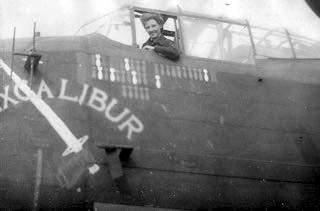
Left: Elsie at the controls in 'Excalibur'.
During their tour of ops at Kelstern the crew was driven to and from their aircraft by WRAF members of the Motor Transport pool. These included a thoughtful, intelligent and courageous Elsie Brannan. Over the months romance blossomed. On August 2/44 P/O. Price married Elsie at Saint Mary’s Church in the village of Tutbury, Staffordshire. They would be inseparable for the next sixty-seven years, raising their children and grandchildren.
At the end of their tour of operations three of the crew were awarded the Distinguished Flying Cross: P/O.'s Price, Ball and Conley. P/O. Price’s DFC citation notes that he “ completed 31 sorties comprising 213 operational flying hours as the captain of a Lancaster aircraft. This officer has carried out his tour of operations displaying quiet persistence and a cool, determined endeavour over a long period, sometimes under most trying circumstances, and for the success he has achieved I consider he fully deserves an award of the Distinguished Flying Cross.” The citation noted his “ cool and skilful manner” he displayed in handling the double engine failure on takeoff. In retrospect Reg humbly states that his DFC was awarded to the crew in its entirety.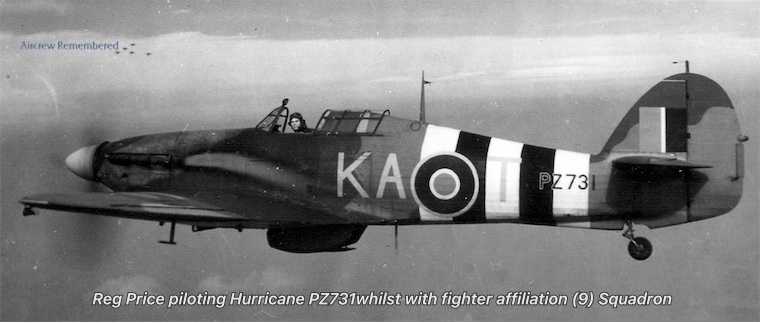
Above: taken during his posting to a fighter affiliation squadron where Reg Price spent most of his tours on Wellingtons but also was checked out on the Hurricane. Between July 7, 1944 and January 4, 1945 he logged a total of 73 hours 5 minutes on type. Most unusual for a bomber pilot to experience the perspective of an attacking fighter pilot.
On the completion of their tour of operations the crew were posted to Operational Training Units and Conversion Units. P/O. Price completed his war service with 82 OTU as a fighter affiliation instructor flying a mix of Wellingtons and Hurricanes. Two of his crew were not as fortunate.
Tragically Fl/Sgt. Powter (1) was killed by a V-1 bomb while on leave in London visiting his girlfriend and Reg’s best man, F/O. Dudley Ball (2), lost his life in a flying accident before war’s end. Reg’s son is named in memory of his friend and devoted navigator.

Above L-R; Reg Price and Elsie on their wedding day, Medals including his DFC and the French Legion D' Honour, Reg Price 2016.
After the war Reg returned to Canada with Elsie. After obtaining a Short Term Commission with the RAF, he, Elsie and their son returned to England in 1947 and for the next five years flew Lancasters and Handley Page Hastings. This was followed by thirteen years with the RCAF as a Harvard instructor and North Star captain. On retiring from the RCAF Reg worked as a check pilot for the Department of Transport. He completed his aviation career as a corporate pilot with 20,000 hours of flight time - worldwide and into the jet age. He maintained contact with his wartime comrades to the end. Jack Conley was the last surviving crew member in Australia.

September 12/2016. Reg, age 95, lives in his house in Victoria, B.C., drives, walks regularly with other members of the Aircrew Association. He still grieves after Elsie's unexpected death on November 28, 2013 - age ninety three. He is indeed a veteran and a survivor - symbolic of all the brave aircrew that chose to fly in combat in the night skies over Occupied Europe. The majority were not as fortunate. They failed to return or did so physically or mentally scarred for life.
(Webmaster note: Lost from the Squadron during the Düsseldorf operation Lancaster I ED321 CF-V Flown by Fl/Sgt. John Gladstone Blackwood 656138 RAFVR from Glasgow, Scotland - killed with all 7 crew over the target area.)
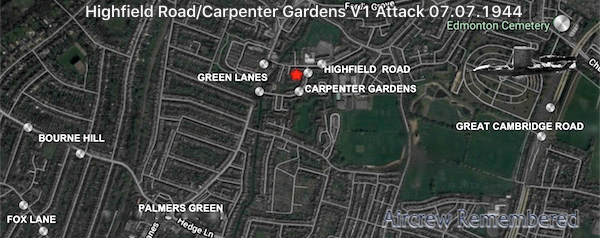
(1) Fl/Sgt. Harry William Powter - thought to have died from his injuries following a V1 or V2 attack on London on the 07th July 1944. (see map) The ARP report stated "Big incident at 01:05hrs. and fire at Highfield Road - Carpenters Gardens - many casualties, some trapped, gas mains on fire, school damaged as well as food shops, rescue operations proceeding, homeless accommodated in rest centre.
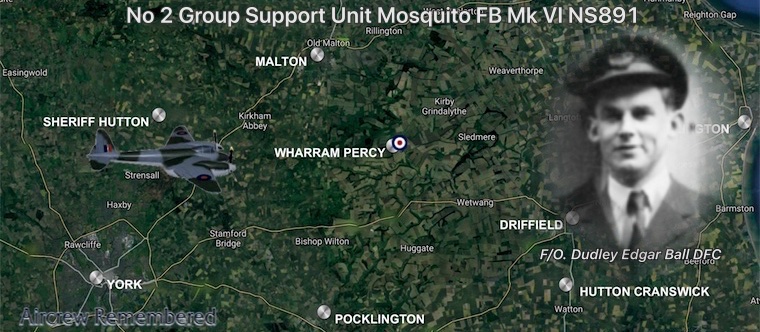
(2) Fl/Lt. Dudley Edgar Ball DFC killed flying Mosquito FB MkVI NS891 on the 10th January 1945. Fl/Lt. Laurence Gerard Sullivan DFM, also a pilot, was killed with him when the aircraft struck a tree whilst practising low flying. At the time they were attached to No. 2 Group Support Unit. (see map) The family of Fl/Lt. Sullivan had suffered the loss of his younger brother, Sgt. Maurice Anthony Sullivan GM. AUS/400359 who went missing on the 18th December 1941. An air gunner with 7 Squadron when Stirling N3680 MG-Y was shot down off Brest with all 7 crew members missing and commemorated on the Runnymede Memorial.
Burial details:
Crew all survived this operation, others mentioned within this report:
Fl/Lt. Dudley Edgar Ball DFC. Harrogate Cemetery (Stonefall) Sec. H. Row E. Grave 4. Son of William James Edgar and Dorothy Ball, of Lidcombe, New South Wales, Australia. Grave inscription reads: "At The Going Down Of The Sun And In The Morning We Remember".
Fl/Sgt. Harold William Powter. Edmonton Cemetery, Middlesex. Sec. W. Grave 13. Son of Herbert William and Violet Beatrice Powter, of Enfield Wash, London, England. Grave inscription reads: "To The World He Was Only One, To Us, He Was All The World. Mum And Dad".
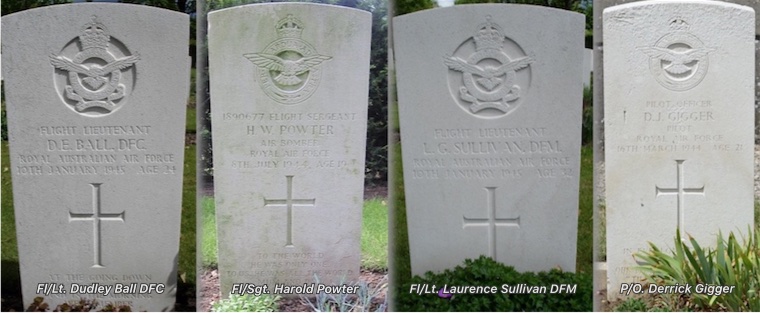
Fl/Lt. Laurence Gerard Sullivan. Harrogate Cemetery (Stonefall) Sec. H. Row E. Grave 3. Son of John Henry and Ellen Frances Sullivan, of Macarthur, Victoria, Australia. Grave inscription reads: "Requiescat In Pace".
P/O. Derrick John Gigger. Dannes Communal Cemetery. Row B. Grave 2. Son of John Henry and Elsie Winifred Gigger (née Hussey) of Eynsford, Kent, England. Grave inscription reads: "In Everloving Memory Of Our Beloved Son And Brother "Till We Meet Again".
Researched by Jack Albrecht with information supplied by Reg Price and John Proctor and dedicated to the relatives of this crew. Also thanks to sources quoted below.